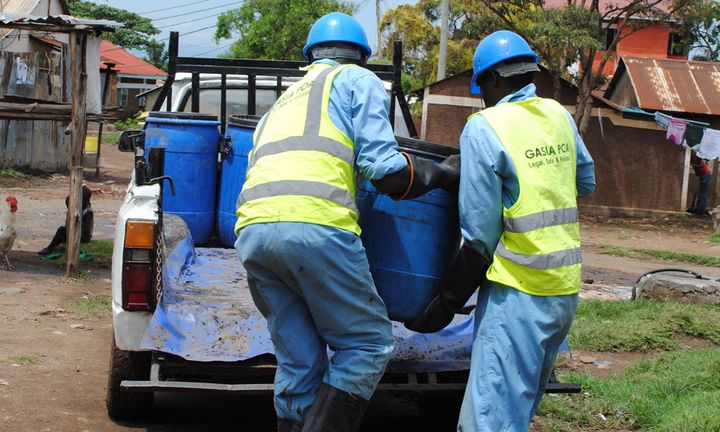
Pit-emptiers at work in Kisumu, western Kenya
A few months ago, I took part in a Guardian Global Development Professionals Network debate on the effectiveness of Public-Private Partnerships (PPPs) in international development. The other panellists in general took a questioning view of PPPs, understandably cautious after high-profile cases between the private sector and governments have not delivered what was promised, or did not offer value for money.
As I listened to my fellow panellists, I realised that although we all had different views of the strengths and weaknesses of PPPs, we all agreed about what PPPs are trying to achieve, or at the very least, the gaps that they are trying to bridge.
At current funding rates, the Sustainable Development Goals will not be realised. The World Bank estimates that countries need to invest $114 billion per year (more than triple their current spending) on infrastructure to reach the drinking water and sanitation targets – and this doesn’t include the cost of operating and maintaining infrastructure after it has been built.
This projected shortfall means the opportunity to reach millions of people who need improved water and sanitation will be missed – and by a long way. Right now, one in four urban residents in sub-Saharan Africa currently lack access to safe sanitation services – and as cities grow, this number is likely to get worse.
To combat this challenge, African and Asian governments cannot be solely dependent on international funders – they need to find their own ways to generate resources for the provision of basic services.
The private sector can provide some of these resources. But is it possible to harness the power of the market to reach the poorest with adequate services at an affordable cost?
At the Guardian event, I think the main reason I differed from my fellow panellists about PPPs is because I don’t associate them exclusively with huge infrastructure projects and multi-million dollar contracts. At WSUP, we focus on partnerships between the public and private sectors that are more collaborative, on a smaller scale and designed to encourage the private sector to enter markets that they had previously regarded as unprofitable and/or too risky, such as the provision of sanitation service to low income consumers.
WSUP believes that both the public and private sectors have a role to play in delivering these services: PPPs are an adaptable and flexible mechanism to bring these stakeholders together so that their strengths and weaknesses are balanced.
One of the biggest challenges faced by cities and governments in the provision of financially viable water and sanitation services is the issue of collection and safe treatment of faecal waste in poor communities, where toilets are not connected to sewers. Often, pit latrines or septic tanks are emptied manually, providing a poor service to consumers and representing significant risk to the worker; additionally the waste may be illegally dumped, which contaminates the environment and water supplies.
WSUP believes that the involvement of the private sector can help bring a solution – if we can find the right approach.

A private sector operator providing essential waste collection services in Maputo, Mozambique
For example in Bangladesh, we identified that high up-front capital costs are a key obstacle to private sector engagement in the market.
So our solution: a partnership whereby a private sector operator was able to lease equipment owned by the public sector, lowering barriers to entry into that market. We enabled the operator to deliver a financially viable service, by introducing a differential pricing structure that maintains profitability for the operator, whilst ensuring the service is also affordable for low income customers.
The collection, safe transportation and treatment of waste from poor communities benefits customers, businesses operating the service, and the public sector; and the latter receives regular stable income from the lease of its equipment and capital assets. Our partnership is called SWEEP and you can read more about it here.
Similarly in the city of Kisumu, Kenya, we’re supporting a garbage management business to move into sanitation. The business owner has received the support needed from the County Public Health Office to meet health regulations, and the city utility is allowing it to dump faecal waste at one of its treatment facilities, so that the business Gasia Poa can deliver a safe pit-emptying service to poor urban consumers.
To help develop PPPs further, we have recently published reports exploring the role of Public-Private Partnerships in delivering sanitation services in three countries – Bangladesh, Kenya and Zambia.
The underlying idea that guides WSUP is that the aims of the public and private sectors overlap a great deal more than you might think – and that the water, sanitation and hygiene sector must take advantage of that if we are to achieve the SDGs.
The solution lies in, firstly, successfully harnessing the power of the market to deliver services and secondly, at the same time recognizing that the public sector can and must shape the ground upon which those services are delivered.
It is regulators and municipalities, after all, that play a vital role in ensuring the rules are clear and adhered to by all service providers, so that no section of society is left behind.